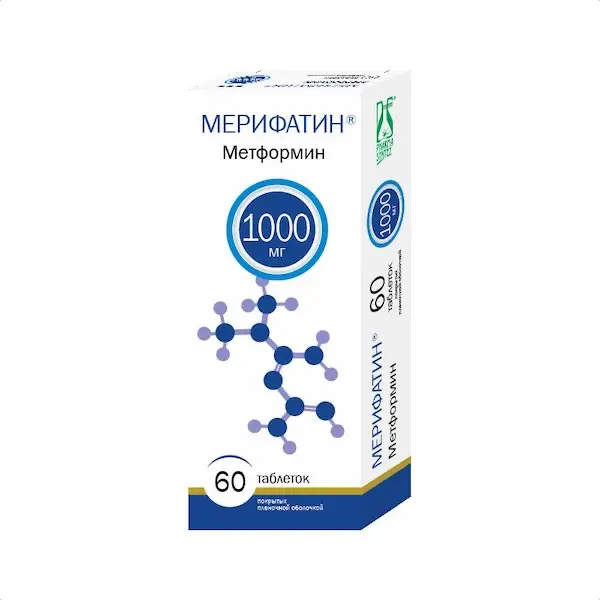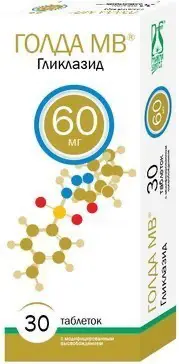Description
Glibenclamide Pharmacodynamics
Glibenclamide has pancreatic and extrapancreatic effects.
It stimulates insulin secretion by decreasing glucose irritation threshold of pancreatic beta-cells, increases insulin sensitivity and binding degree to target cells, increases insulin release, increases insulin influence on glucose uptake by muscle and liver, inhibits lipolysis in adipose tissue (extrapancreatic effects). Acts in the second stage of insulin secretion.
It has a hypolipidemic effect, reduces thrombogenic properties of blood.
Hypoglycemic effect develops after 2 hours, reaches a maximum after 7-8 hours and lasts 12 hours. The drug provides smooth increase of insulin concentration and smooth decrease of plasma glucose concentration, which reduces the risk of hypoglycemic states.
Glibenclamide activity is evident in preserved endocrine function of the pancreas.
Indications
Type 2 diabetes mellitus as monotherapy or in combination therapy with other oral hypoglycemic agents, except sulfonylurea derivatives and glinides.
Contraindications
– Hypersensitivity to glibenclamide and/or any excipient of the drug;
– Hypersensitivity to other sulfonylurea derivatives; sulfonamides; diuretics containing sulfonamide group in the molecule; probenecid, since cross-reactions may occur;
– type 1 diabetes mellitus;
– diabetic ketoacidosis, diabetic precoma and coma;
– Condition after pancreatic resection;
– Severe liver dysfunction;
– severe renal impairment (creatinine clearance < 30 ml/min);
– severe insufficiency of the adrenal cortex;
– decompensation of carbohydrate metabolism in infectious diseases, burns, injuries, or after major surgery when insulin therapy is indicated;
– leukopenia;
– Intestinal obstruction, paresis of the stomach;
– hereditary lactose intolerance, lactase deficiency or glucose and lactose malabsorption syndrome;
– Pregnancy and breastfeeding;
– Under 18 years of age (effectiveness and safety have not been studied).
– porphyria;
– Glucose-6-phosphate dehydrogenase deficiency;
– concomitant use with bozentan.
How to use and dosages.
- Inside. The drug should be taken before a meal, without chewing and with plenty of liquid. The drug should be taken at the same time of day.
- Dosage of the drug is chosen individually, depending on the age and severity of diabetes mellitus course, blood glucose concentration on an empty stomach and 2 hours after a meal.
- Tablets 5 mg. The tablet may be divided into 2 equal parts. The daily dose range is 1/2 to 3 tablets (2.5 mg to 15 mg). The starting dose is 2.5 to 5 mg (1/2 to 1 tablet) per day.
The maximum daily dose is 15 mg (3 tablets). - The dose should be increased at intervals of several days to 1 week until the required therapeutic dose is reached, which should not exceed the maximum dose.
Tablets 1.75 mg. The initial dose is usually 1-2 tablets (1.75 mg-3.5 mg) once daily. The average daily dose is 3.5 mg (2 tablets). If necessary, the dose is gradually increased until compensation of carbohydrate metabolism is achieved. - The maximum daily dose is 6 tablets (10.5 mg).
If it is necessary to take more than three tablets, the dose is switched to 3.5 mg tablets. - The dose should be increased at intervals of several days to one week until the required therapeutic dose is reached, which should not exceed the maximum dose.
3.5 mg tablets. The initial dose is usually ½-1 tablet once a day. The average daily dose is 3.5 mg (1 tablet). If necessary, the dose is gradually increased until compensation of carbohydrate metabolism is achieved. - The maximum daily dose is 10.5 mg (3 pills).
- Daily doses of up to 2 pills are usually taken once a day – in the morning. Higher doses are divided into 2 receptions – morning and evening receptions at a ratio of 2:1.
If one dose of the drug is missed, the next dose should be taken at the usual time, and it is not allowed to take a higher dose. - Transition from other hypoglycemic drugs
When switching from other hypoglycemic drugs with similar type of action, Glibenclamide is administered according to the scheme given above, and the previous drug is immediately cancelled. - Use in combination therapy with other hypoglycemic drugs
Glibenclamide can be used in combination therapy with metformin and other oral hypoglycemic agents that do not stimulate insulin secretion by the beta-cells of the pancreas. - Use in elderly, debilitated patients and patients with reduced nutrition
In elderly, debilitated patients or patients with poor nutrition, the initial and maintenance doses should be reduced because of the risk of hypoglycemia. - Administration in patients with impaired renal and hepatic function
Glibenclamide is contraindicated in patients with severe renal and hepatic impairment. In patients with mild to moderate renal dysfunction (creatinine clearance > 30 ml/min) and mild to moderate hepatic dysfunction, the initial and maintenance doses should be reduced because of the risk of hypoglycemia.





